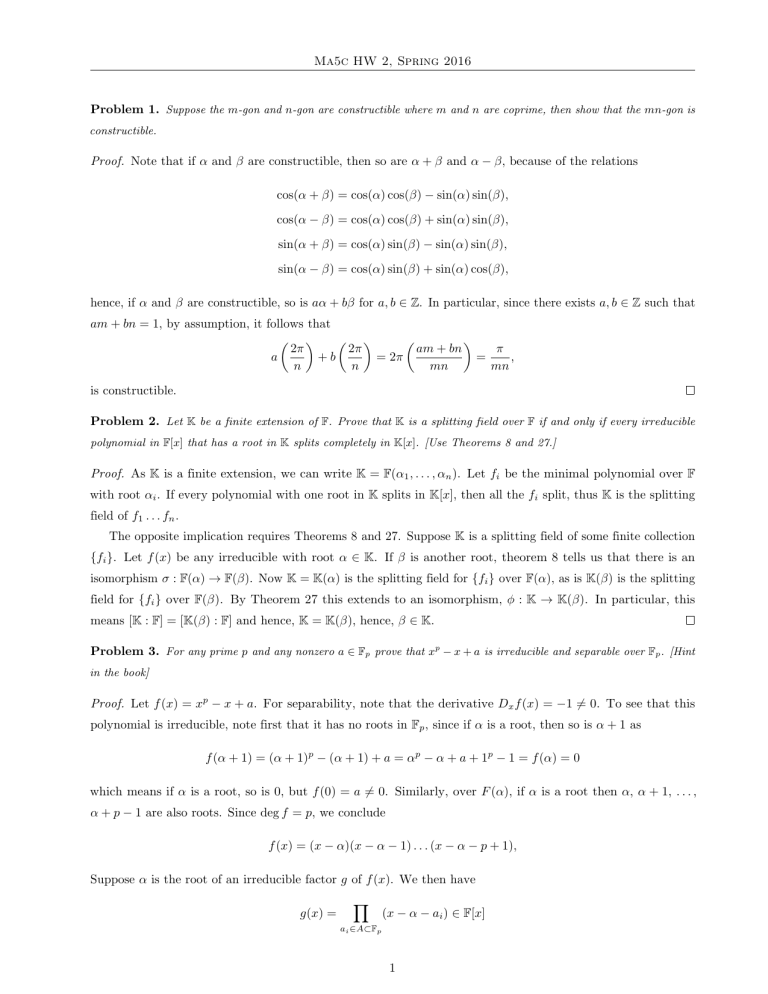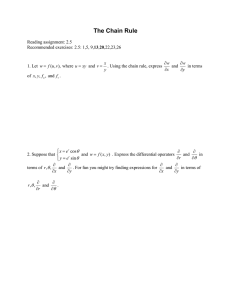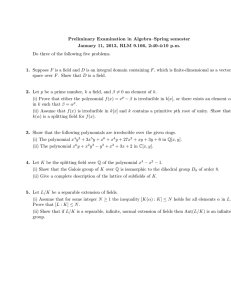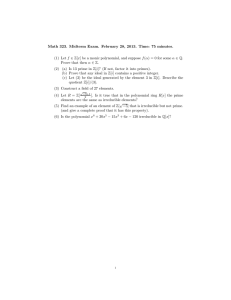Ma5c HW 2, Spring 2016 Proof. Note that if α and β are constructible

Ma5c HW 2, Spring 2016
Problem 1.
Suppose the m -gon and n -gon are constructible where m and n are coprime, then show that the mn -gon is constructible.
Proof.
Note that if α and β are constructible, then so are α + β and α − β , because of the relations cos( α + β ) = cos( α ) cos( β ) − sin( α ) sin( β ) , cos( α − β ) = cos( α ) cos( β ) + sin( α ) sin( β ) , sin( α + β ) = cos( α ) sin( β ) − sin( α ) sin( β ) , sin( α − β ) = cos( α ) sin( β ) + sin( α ) cos( β ) , hence, if α and β are constructible, so is aα + bβ for a, b ∈
Z
. In particular, since there exists a, b ∈
Z such that am + bn = 1, by assumption, it follows that a
2 π n
+ b
2 π n
= 2 π am + bn mn
=
π mn
, is constructible.
Problem 2.
Let
K be a finite extension of
F
. Prove that
K is a splitting field over
F if and only if every irreducible polynomial in
F
[ x ] that has a root in
K splits completely in
K
[ x ] . [Use Theorems 8 and 27.]
Proof.
As
K is a finite extension, we can write
K
=
F
( α
1
, . . . , α n
). Let f i be the minimal polynomial over
F with root α i
. If every polynomial with one root in
K splits in
K
[ x ], then all the f i split, thus
K is the splitting field of f
1
. . . f n
.
The opposite implication requires Theorems 8 and 27. Suppose
K is a splitting field of some finite collection
{ f i
} . Let f ( x ) be any irreducible with root α ∈
K
. If β is another root, theorem 8 tells us that there is an isomorphism σ :
F
( α ) →
F
( β ). Now
K
=
K
( α ) is the splitting field for { f i
} over
F
( α ), as is
K
( β ) is the splitting field for { f i
} over
F
( β ). By Theorem 27 this extends to an isomorphism, φ :
K
→
K
( β ). In particular, this means [
K
:
F
] = [
K
( β ) :
F
] and hence,
K
=
K
( β ), hence, β ∈
K
.
Problem 3.
For any prime p and any nonzero a ∈
F p prove that x p − x + a is irreducible and separable over
F p
. [Hint in the book]
Proof.
Let f ( x ) = x p − x + a . For separability, note that the derivative D x f ( x ) = − 1 = 0. To see that this polynomial is irreducible, note first that it has no roots in
F p
, since if α is a root, then so is α + 1 as f ( α + 1) = ( α + 1) p − ( α + 1) + a = α p − α + a + 1 p − 1 = f ( α ) = 0 which means if α is a root, so is 0, but f (0) = a = 0. Similarly, over F ( α ), if α is a root then α , α + 1, . . . ,
α + p − 1 are also roots. Since deg f = p , we conclude f ( x ) = ( x − α )( x − α − 1) . . .
( x − α − p + 1) ,
Suppose α is the root of an irreducible factor g of f ( x ). We then have g ( x ) =
Y a i
∈ A ⊂
F p
( x − α − a i
) ∈
F
[ x ]
1
Ma5c HW 2, Spring 2016 where | A | = deg α = k . Expanding this expression out we get g ( x ) = x k
+ x k − 1 kα +
X a i
!
+ . . .
a i
∈ A
The coefficient of x k − 1 should be in
F p
, since g ∈
F p
[ X ]. Since α /
F p
, we must then have k = p , hence, g = f ( x ).
Thus f is irreducible.
Problem 4.
Suppose
K is a field of characteristic p which is not a perfect field:
K
=
K p
. Prove there exists a irreducible inseparable polynomials over
K
. Conclude that there exists inseparable finite extensions of
K
.
Proof.
Let a be an element of
K that does not arise as a p -th power. Since this is the case, the polynomial f ( x ) = x p − a, has no root over
K
. It is irreducible and D x
( f ( x )) = 0 implies that ( D x
We construct the field extension
K
( α =
√ p a ) /
K where a
( f ( x )) , f ( x )) = 1, hence, it is inseperable.
is as above. The minimal polynomial for α is x p − a which is irreducible and inseparable.
Problem 5.
Suppose that f ( x ) ∈
F
[ x ] is irreducible (and hence separable) over a field of characteristic 0. Show that if
α and β are both roots of f ( x ) (in the splitting field over
F
), then α − ∈
F
.
Proof.
Suppose that α − β = γ where γ ∈
F
, then we may write
β = α − γ.
Since f ( x ) is irreducible, it is a multiple of the minimal polynomial for α . Let us consider the polynomial g ( x ) := f ( x − γ ) ∈
F
[ x ] .
If x = α , then f ( β ) = 0, hence, g ( α ) = 0. This implies that f ( x ) divides g ( x ), but g ( x ) is of the same degree and has the same leading coefficient, hence g ( x ) = f ( x ) = f ( x − γ ), i.e., f ( x ) − f ( x − γ ) = 0. Suppose f ( x ) = a n x n
+ . . .
+ a
1 x + a
0
, with a n
= 0. Then f ( x ) − f ( x − γ ) = a n x n
+ a n − 1 x n − 1 − a n
( x − γ ) n − a n − 1
( x − γ ) n − 1
+ . . .
= a n nγx n − 1
+ . . .
= 0
Since we are working in characteristic 0, we must have either a n
= 0 or γ = 0. Neither is true.
2





